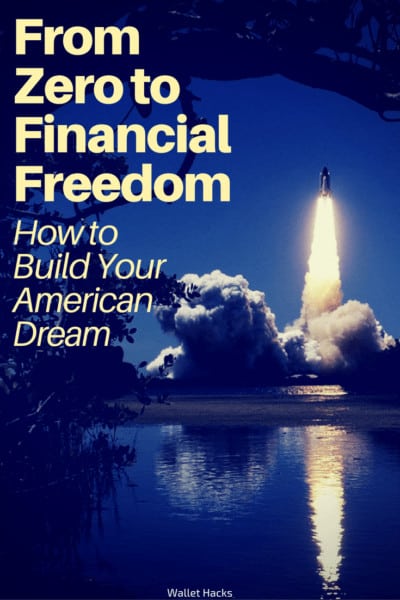One of the most popular articles on Wallet Hacks is about the 7 passive income streams of millionaires – it walks you through my framework for thinking about wealth building. Active income, passive income, accumulating wealth, financial gravity – the whole lot.
When Scott Trench approached me about his new book, Set for Life, I was intrigued because it reminded me a lot of that post. Whereas I was sharing my mental model of wealth building, his book outlined exactly how to achieve financial freedom based on similar core principles in that model. I don't do many book reviews, I don't take many guest authors on the site, but Scott is a sharp guy and after reading his book, I wanted to share some of that knowledge with you because it's that good.

The most powerful idea in his book is that financial freedom is attainable for everyone and his book outlines actionable steps towards achieving it.
In this guest post, Scott shares the idea of a financial runway, how you build it (including how your approach changes depending on how much runway you have), and how you use it to create a self-fulfilling prophesy of financial freedom.
It's best to think of this like a 30,000′ foot flyover of his book.
Take it away Scott:
Financial Runway and Living the Real American Dream
Imagine this:
Folks in a position like this, even if they have hundreds of thousands of dollars in their retirement accounts or home equity, are extremely limited financially. Even six months without work can wipe out their paltry savings and put them into panic mode.
Enter the Financial Runway.
A Financial Runway is the amount of time you could survive without the need for wage-paying work or actively working to produce income.
It’s dependent on two variables:
- How much money you spend per month or per year
- How much cash you have access to right now
If you spend $5,000 per month, and have $10,000 in the bank, or even $10,000 in stocks or other investments that you could sell at a moment’s notice, you have a financial runway of about two months. On the other hand, if you have $20,000 in cash and spend just $2,000 per month, you have ten months of financial runway.
Related: If this sounds like budgeting, it's because it is. See our best budgeting apps to help you find out these numbers.
If you aspire to early financial freedom, then I’d argue that your goal should be to accumulate as much financial runway as you possibly can, as fast as you can. You need to build that thing out to 1 year. Then 4-5 years. Then, you need to extend it so that your financial runway is infinite.
I break out this journey into three parts.
- Part I involves building out the first $25,000, or first year of financial runway for a frugal person.
- Part I involves building out four-five years of financial runway, or perhaps $100,000 for the frugal person.
- Part III involves finishing out the journey toward financial freedom so that your runway is infinite.
Each part requires a different approach and mode of thinking.
Part 1: The First $25,000, or full year of financial runway is the hardest
As a full-time employee with little free time and few assets to invest, your path forward is clear for generating the first $25,000. Start saving. Aggressively.
You aren’t going to bring about early financial freedom if you make $75K per year but spend $60. You need to spend as little as you practically can.
Obviously, you aren’t going to get there by cutting out your lattes.
No, the way that you truly tackle your expenses is by cutting out the huge parts of your budget. I’m talking about housing, transportation, and your food budget. That’s two-thirds of American spending right there. Eliminate that from your budget, and you will be making really big strides towards early financial freedom. Fail to do so, and I hope you like your job, because you’ll be there for decades.
While there are many ways to creatively do this, for many folks that don’t live in New York, San Francisco, or Los Angeles, the obvious approach to eliminating 50% or more of your expenses is through house-hacking close to work.
What does that mean? It means that you buy an investment property with extra units (like a duplex, triplex or quad, or even a single-family home with extra bedrooms) and use tenant rent to pay down your mortgage. Done correctly, and with careful research, you can eliminate your housing expense entirely.
I’ve done this for the past 3 years here in Denver, CO, one of the more expensive markets in the country. You can too. My housing expense is negative. I collect cash every month. And, I’m close enough to my workplace that I can make a 5 mile bike ride every day to work without even breaking a sweat. While I’m a single guy and typically write for young people, families can imitate this with similar results—think of it like living in a townhome.
However you do it, get to the point where you are saving well over 50% of your income if you want to build out a year of financial runway in 12 months or less.
And, you can keep spending freely on all the fun stuff, like entertainment, booze, vacations and more. It’s not the little stuff that adds up, it’s the big parts of your budget that are preventing you from moving rapidly toward early financial freedom.
And I’m here to tell you that those big expenses are entirely optional.
Part 2: Build $25,000 -> $100,000 in Financial Runway
Assuming that you are able to live quite happily on $25,000 or less, and have a solidly paying job, you’ll be extending your financial runway quite automatically after a year or so of making smart choices.
It’s time to start focusing on your income.
Unfortunately, your full time job will hold you back in many cases. See, you know, for certain, that the best case scenario for your typical “database specialist II” is going to be a promotion next year to “senior database analyst” and a raise from $65K per year to $72K per year. That’s the best case scenario.
But that’s not any way to progress toward financial freedom.
You need something that offers more scale than that, and something that you can work on full-time with your best efforts. While it’s possible to build a side hustle or businesses after a full-day’s work, to me that approach makes little sense. Why waste the best part of your day working at a job that offers so little upside, and work on your real passion at night?
Now, the guy with less than a year of financial runway can’t try something new. He spends all of his paycheck and has no runway left over. If he loses his job, he’s screwed. Not you though. You live frugally and have $25K+ saved up. You could easily get by on half your salary. Or, no salary at all for a full year.
You can pursue opportunity now. When that job that offers a 20% reduction in base pay, but a sweet options deal, or a chance at some serious sales commissions comes your way, you can pounce on that. You can take a shot at making the big bucks and pursue your dreams. You can do that because of your financial runway and the low cost lifestyle you’ve developed for yourself.
Part 3: Moving from $100,000 toward Early Financial Freedom By Acquiring “Real” Assets
Alright. The ball’s rolling now. You are earning some big money ($100K per year or more, depending on your local cost of living) and spending very little money. It’s time to really begin designing an effective portfolio that can sustain early financial freedom.
This isn’t about building a nest egg. It’s not about becoming wealthy at 65.
In fact, middle-class American homes hold people back from achieving early financial freedom.
The guy with a $400,000 home and a $300,000, $2,000 per month, mortgage destroys his financial runway. He is not going to deploy that $100,000 so that he can live off of it while building a business, or even invest it to produce passive income. AND, he limits his savings rate by $2,000 per month with the mortgage! The same rings true for retirement accounts.
To caveat this a bit, it’s not bad to have home equity or retirement accounts. It’s better to have money in a 401(k) than to not have money in a 401(k). Please don’t misinterpret this.
I’m merely saying that you can’t become financially free at an early age if all or most of your wealth building is in those two places! I do contribute a bit to my 401(k) and I definitely take any matches I can get. I just save way more than that outside of my 401(k) and use that to invest in things that can provide real, usable wealth and cash flow.
Build or buy “Real” assets.
Real assets include things like businesses, stocks, real estate rental properties, debts, or alternative investments that will both produce spendable cash flow today and appreciate at a faster rate than inflation. Design your investing strategy around the production and accumulation of those assets, and you’ll rapidly finish out the journey toward early financial freedom.
The reason that you can save your investing strategy and the accumulation of real assets for last is that investing doesn’t really have a big impact until you have a substantial nest egg saved. Saving your money is still important but obsessing about investments isn't.
Figuring out how to get a 25% annual return (an absurdly high return) on $1,000 will produce just $250 over the course of a year. That’s great, but you can’t quit your job, move, buy a new car, or really do anything that will impact your life significantly with just $250. You can’t even really make a life changing difference with 25% returns on a $10,000 investment!
Invest $100,000, however, and achieve a 12% annual return, and you are generating $1,000 per month. That’s still a high return, but not absurd for someone willing to do some work and hustle. An extra $1,000 per month might well have a real impact on your life, and allow you to make decisions that you might not otherwise be able to.
Conclusion
Work hard. Spend as little as possible. Invest the difference in real assets. Set yourself up for life as early as you possibly can.
If you do this early enough in life, you stand a great shot at having an impact on the world far greater than you might if you fail. You expand your opportunities to creatively pursue your passions and interests. You can work when you want to, not when your boss wants you to.
Don’t be satisfied with the mediocre plan of working a median job, saving 10-15% in a 401(k) and retiring after a 30 or 40 year career. Instead, save as much as you possibly can and use your frugal position with a big cash cushion to take a chance on the real American Dream.
This discussion about early financial freedom is a brief synopsis of many of the points discussed in Set for Life. The book goes into far greater detail on the specifics of cutting back on your expenses, house-hacking, earning more income and setting yourself up for professional success, and of course, the acquisition and management of investments and real assets that expedite financial freedom.
I hope that Set for Life helps you to build out your financial runway rapidly and allow you to pursue opportunities and early financial freedom as efficiently as possible. Order Set for Life now on Amazon, Bookshop, and Barnes and Noble.







Syed says
Very engaging article. I really enjoy Scott’s posts at BiggerPockets and will definitely be giving this book a read.
Scott Trench says
Thanks Syed! I hope you love the book!
Andrew says
Big fan of BP and listened to the recent podcast about the book! Really awesome because it talked about personal finance AND real estate investing which are both topics I really enjoy.
Charles L Thames II says
Thank you very much for your insight and tips in this article.
It’s funny, the overall point of “spending less” and “cutting out the big expenses” is something that we all have HEARD and KNOW we should be doing. We just don’t.
It was great to have that reinforced along with other helpful financial tips. I personally am starting a new job and chapter in my life. The biggest part of my new story will be spending less and saving more in the right areas.
Thanks again for your time and talent in writing this article.
Cheers,
“New Beginnings “